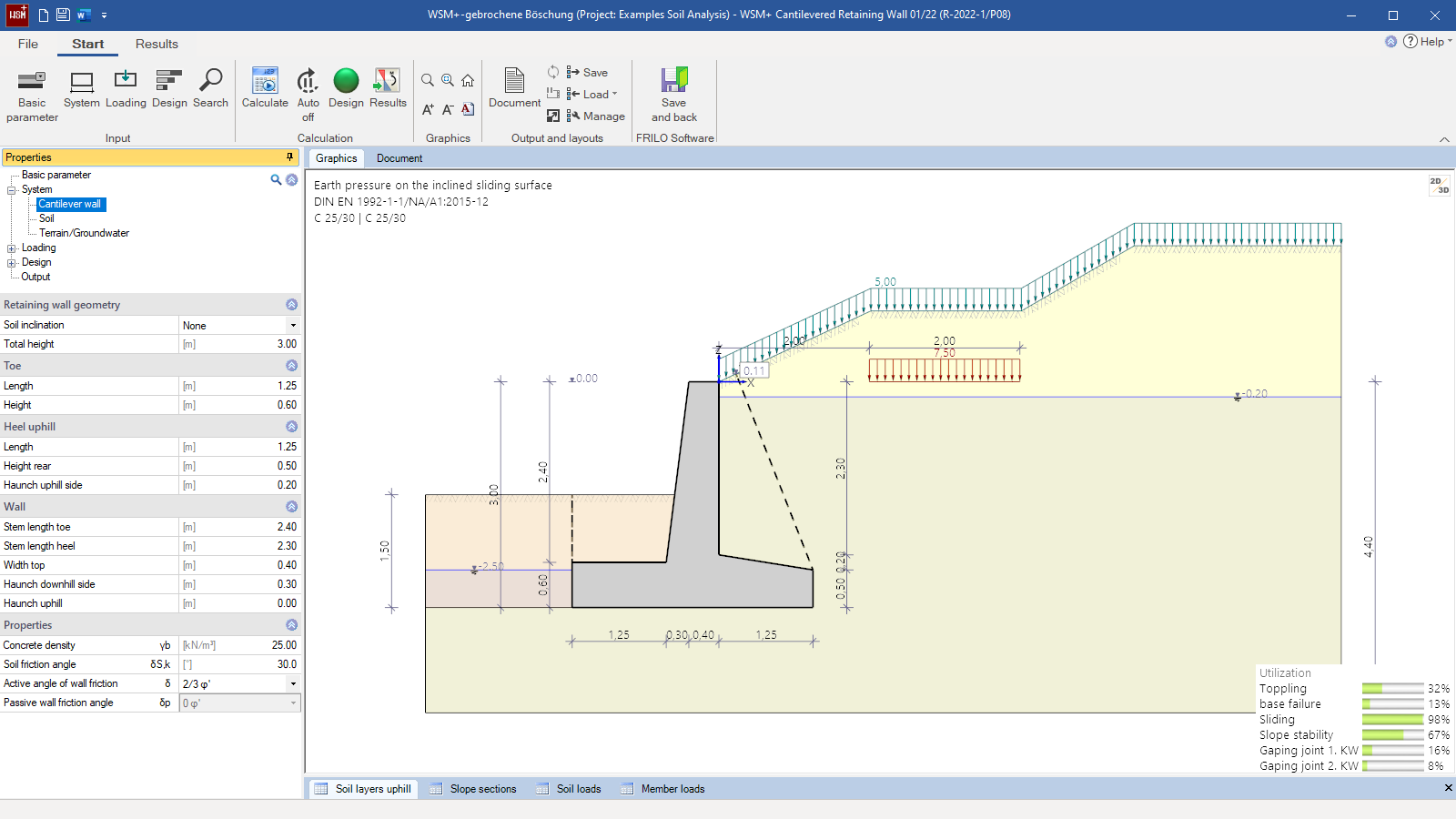
Cantilevered Retaining Wall
WSM+
The WSM+ program can be used to verify the internal and external load-bearing capacity of cantilevered retaining walls. The user can define a toe (front) and a heel (rear). The toe and heel as well as the wall front and rear faces can have any inclinations. The soil can consist of any number of horizontally limited soil layers. Stagnant groundwater can be considered as well as different earth pressure situations. The ground surface behind the wall can be modelled as a horizontal or continuously ascending surface or with a freely selectable polygonal profile.
Discover now more programs from the section Foundation Engineering!
SHOW MOREMaterial
- Reinforced concrete with selectable wall friction angles
Structural system
- Heel and toes, also with inclination, if applicable
- Any inclination of the wall front or rear face
- Optional inclination of the base slab
Soil:
- Any number of horizontal layers
- Freely selectable soil parameters
- Separate soil layer in front of the toe
Ground surface:
- Horizontal or continuously ascending
- Any number of polygonal ground-surface sections
Groundwater:
- Stagnant groundwater can optionally be defined in the form of groundwater tables at the hill and valley side.
Loads
- Any kind of ground-surface loads in the form of area loads, strip loads, block loads and line loads.
- Area loads, line loads and moment loads acting on the wall crown and the toe.
- Horizontal forces acting at a freely selectable height on the wall and the front face of the toe.
- Free assignment of loads to types of actions according to EC 0 as well as to concurrency and alternative groups.
Earth pressure
- Can optionally apply either to the vertical section or to the inclined plane of rupture
- Separate earth pressure applications for the verifications of the internal and external load-bearing capacity
- Earth pressure at rest, active or any increased active earth pressure
- Optionally with minimum earth pressure or compaction earth pressure
- Optional earth resistance at the front face of the toe
Reinforced concrete design of the wall
- Any number of design sections along the wall
- Durability verification via exposure classes
- Consideration of different minimum reinforcement quantities
- Optionally, different design options for the wall and the foundation
Geotechnical verifications
- Simplified verification with base pressure resistances (either user-defined or taken from tables of DIN 1045)
- Optional verifications using the accurate calculation method:
- Overturning (with earth resistance share in %, if applicable)
- Sliding (with earth resistance share in %, if applicable)
- Ground failure (with earth resistance share in %, if applicable)
- Optional ground failure analysis with slip circles
- Optional settlement verification
- Serviceability via the verification of the gaping joint
Document file formats
- Word
- Printer
Reinforced concrete design
- Decisive base pressure distribution for the design of the toe and/or heel and the foundation
- Internal forces behaviour inside the wall
- Verification of the resistance to bending and shear force in the ULS with output of the required reinforcement for the wall (at any point) and for the toe/heel (in the contact face)
Geotechnical verifications
- Overview of decisive load case combinations and the results of each verification in the persistent design situation
- Tabular and graphical output of the selected earth pressure and water pressure distributions
- Geotechnical verifications in the ULS (overturning, sliding, ground failure, embankment failure, simplified with base pressure)
- Geotechnical verifications in the SLS (first and second core range, settlements, and torsion)
Geotechnical standards
- DIN EN 1997
- ÖNORM EN 1997
- PN EN 1997
- DIN 1054
- ÖNORM B 4435-2
Reinforced concrete standards
- DIN EN 1992
- ÖNORM EN 1992
- PN EN 1992
- BS EN 1992
- DIN 1045
- ÖNORM B 4700
Support resources
News

FRILO launches version 2024-2 with powerful updates for structural analysis and design
Highlights include the optimised design of Schöck Isokörbe®, the advanced integration of DC foundation engineering programs into the FRILO environment and new RSX interfaces for detail verifications in steel construction.

Load determination for eight-floor perimeter block development with FRILO Building Model
Find out how the structural engineers at bauart Konstruktions GmbH determined the loads for an eight-floor perimeter block development in Frankfurt’s Europaviertel district using the GEO from FRILO.




